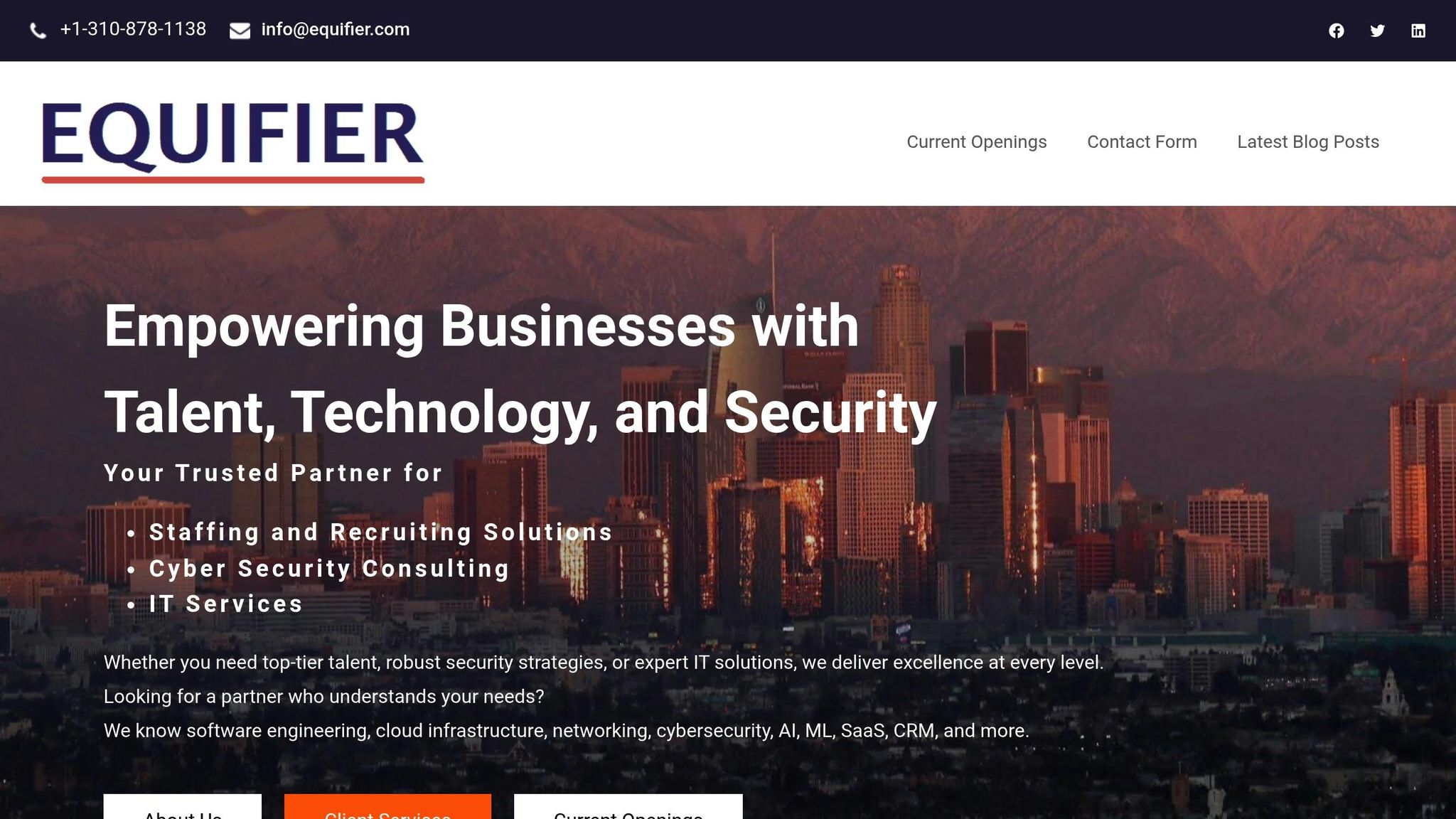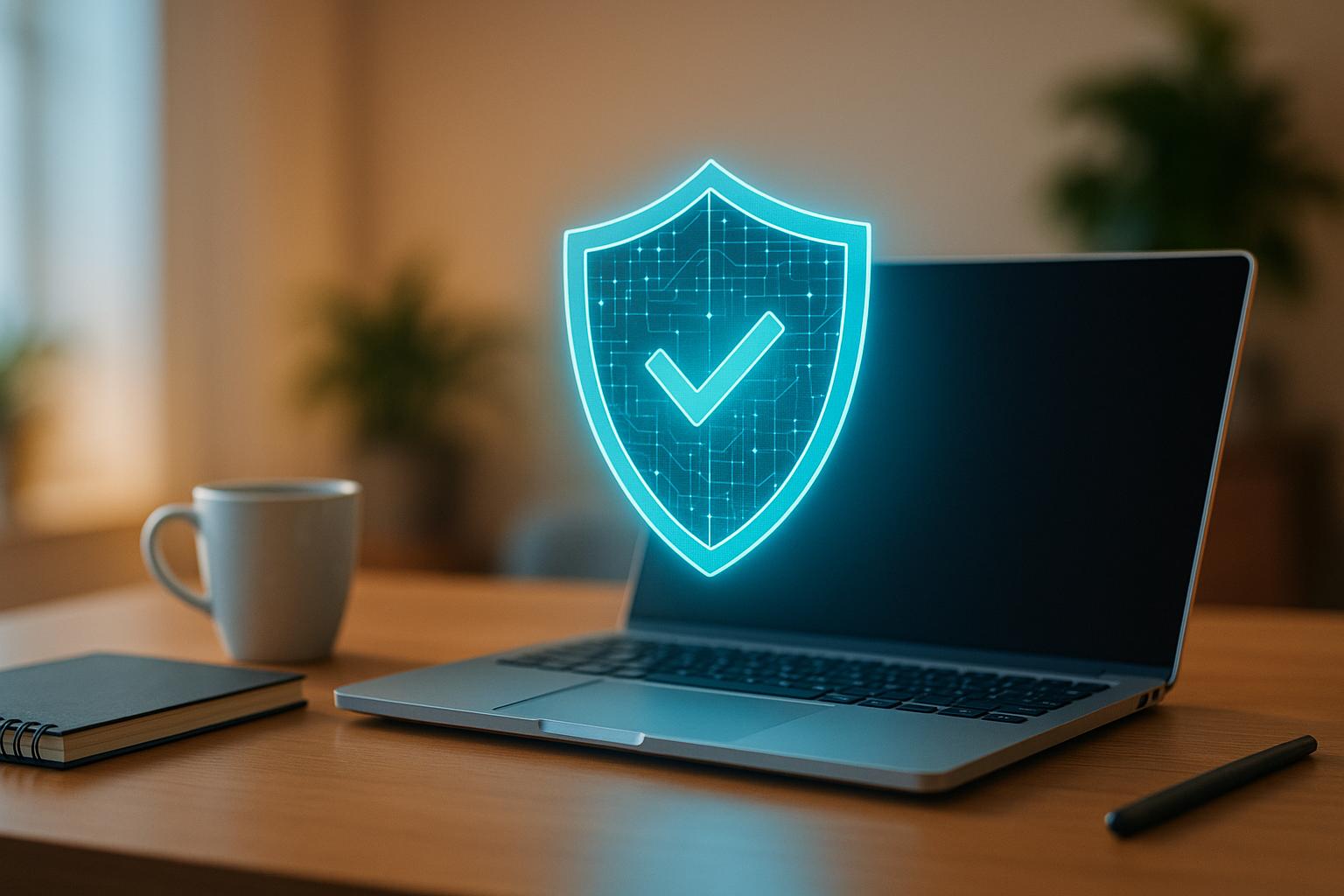Cybersecurity threats are rising, with data breaches costing businesses an average of $4.88 million globally in 2024. For U.S. organizations, conducting regular cybersecurity risk assessments is critical to minimize risks, protect sensitive data, and comply with regulations like FISMA and NIST CSF 2.0. This article outlines a 12-step process to identify vulnerabilities, evaluate threats, and prioritize actions to strengthen your organization’s security posture.
Key Takeaways:
- Cyber Risks Are Growing: Interactive intrusions increased by 60% in 2023, and cloud intrusions rose by 75%.
- Cost of Breaches: The financial impact of a data breach is steep, with small businesses particularly vulnerable (60% close within six months of an attack).
- 12-Step Process: From creating an asset inventory to implementing continuous monitoring, the outlined steps help organizations address risks effectively.
- Frameworks Matter: NIST CSF 2.0 and CISA tools provide structured approaches and resources for improving security measures.
By following this structured process, businesses can prioritize resources, reduce vulnerabilities, and stay ahead of evolving cyber threats.
What Is a Cybersecurity Risk Assessment (and HOW TO DO THEM!)
What Is Cybersecurity Risk Assessment
A cybersecurity risk assessment is a process that identifies, evaluates, and prioritizes potential threats and vulnerabilities within an organization’s IT systems. IBM describes it as:
"A cybersecurity risk assessment is a process used to identify, evaluate and prioritize potential threats and vulnerabilities to an organization’s information systems to mitigate risks and enhance security measures."
This process goes beyond simply spotting security gaps. It evaluates the likelihood and potential impact of various cyberattacks, examines your digital assets, and pinpoints weaknesses in your systems. Ultimately, it provides a clear understanding of where your organization is most exposed to threats.
These assessments play a critical role in safeguarding sensitive information, identifying risks to business objectives, and focusing security investments on the most vulnerable areas. They also lay the groundwork for meeting regulatory requirements and aligning with industry standards.
Regulatory Standards and Frameworks
The Federal Information Security Management Act (FISMA) mandates that federal agencies and their contractors protect government information and systems from cyber threats. FISMA works closely with the National Institute of Standards and Technology (NIST) cybersecurity standards, making compliance essential for organizations handling federal data.
The NIST Cybersecurity Framework serves as the gold standard for U.S. businesses. As the Federal Trade Commission explains:
"The NIST Cybersecurity Framework helps businesses of all sizes better understand, manage, and reduce their cybersecurity risk and protect their networks and data."
In 2024, NIST introduced the Cybersecurity Framework 2.0 (CSF 2.0), its most significant update since 2018. This version broadens its focus beyond critical infrastructure, making it applicable to a wider range of organizations, regardless of their cybersecurity expertise. CSF 2.0 emphasizes the importance of cybersecurity governance as part of enterprise risk management, encouraging businesses to integrate security into their overall strategies.
The framework is built around five core functions: Identify, Protect, Detect, Respond, and Recover. These functions provide a structured roadmap for transitioning from reactive to proactive security measures. While voluntary, the framework is highly adaptable, allowing businesses to tailor it to their specific needs and share insights to support the broader community.
Additionally, CISA offers customized guidance to align organizations with national cybersecurity priorities and provides access to valuable threat intelligence.
The Business Case for Risk Assessments
Conducting regular cybersecurity risk assessments delivers measurable benefits. They help prevent costly incidents like data breaches and system downtime, ensuring both internal operations and customer-facing applications remain functional. With the global average cost of a data breach reaching $4.88 million in 2024, the financial argument for these assessments is strong.
Beyond prevention, a proactive risk assessment supports effective response and recovery planning. It strengthens organizational resilience, minimizing the impact of incidents when they occur. As technology and threats evolve, regular assessments ensure that your security measures stay up-to-date and effective against new challenges.
12 Steps to Conduct a Cybersecurity Risk Assessment
Conducting a cybersecurity risk assessment is no small feat – it requires a methodical approach that leaves no stone unturned in your organization’s digital infrastructure. Below, we break down 12 essential steps to help IT and HR professionals identify vulnerabilities, evaluate threats, and strengthen security measures.
Step 1: Create an Asset Inventory
The first step is building a complete inventory of your organization’s assets. This inventory acts as the backbone of your cybersecurity strategy, offering a clear view of your connected infrastructure. Without it, you risk overlooking critical components that attackers could exploit through unnoticed vulnerabilities or third-party connections.
Catalog all assets, both physical and digital. These include desktops, laptops, servers, smartphones, tablets, printers, firewalls, removable media like USB drives, and even intangible assets such as customer databases, intellectual property, and employee records. HR professionals should ensure systems storing employee data – like payroll software or applicant tracking platforms – are accounted for.
Assign a monetary value to each asset based on current market prices. For example, a server valued at $15,000 demands more robust protection compared to a $500 laptop. This valuation not only helps prioritize security investments but also gives leadership a clear picture of potential financial risks.
Collaboration is key here. Different teams may know of assets that aren’t on standard IT inventories. To help, here’s a quick table summarizing asset classes and their security relevance:
| Asset Class | What It Includes | Common Subsets | Security Risk Relevance |
|---|---|---|---|
| Devices | Hardware storing, processing, or transmitting data | Desktops, laptops, smartphones, servers, IoT devices, removable media | High attack surface; must be tracked across physical, virtual, and cloud environments |
| Software | Programs running on devices | Operating systems, applications, APIs, firmware | Unpatched or unauthorized software poses major risks; inventory aids vulnerability management |
| Data | Information stored or transmitted | Sensitive data (PII, financial, health), backups, log data | A primary breach target; inventory supports encryption, access control, and compliance |
| Users | Authorized people/accounts | Employees, contractors, admin accounts, service accounts | Over-privileged accounts are risky; tracking helps mitigate insider threats |
Once you’ve completed your inventory, focus on identifying which assets and data are most critical to your operations.
Step 2: Find Critical Data and Systems
Pinpointing critical data – like employee records or financial information – is vital. This step is especially relevant for HR departments, given that 3,200 data breaches occurred in the U.S. in 2023, with nearly half involving employee data.
Keith Bigelow, Chief Product Officer at Visier, emphasizes:
"Employee data is critical to secure because it includes employees’ personally identifiable information [PII] and payroll information".
Classify your data based on sensitivity and regulatory requirements. For instance, financial records may fall under SOX compliance, while health data requires HIPAA-level protection. Consider the operational impact of system downtime as well – email servers and customer databases are often essential for daily operations.
Don’t forget to map data flows between internal systems and external services. Many organizations rely on cloud-based HR platforms, payroll processors, and benefits administrators, which can introduce additional vulnerabilities.
Step 3: Map Your Network and System Setup
Using your asset inventory as a foundation, map out your network to understand how data moves within your organization. A detailed network map highlights potential attack paths and weak points. Document everything, from wireless networks and guest access points to connections with partner organizations and cloud services.
Start by outlining your network’s topology, including device connections to switches, routers, and firewalls. Include key details like IP address ranges, VLAN configurations, and segmentation boundaries. This step ensures sensitive systems are properly isolated from general user networks.
Don’t overlook external connections, such as internet gateways, VPNs, and dedicated partner lines. With the rise of remote work, make sure to account for home office setups, mobile devices, and bring-your-own-device (BYOD) policies.
Mapping data flows between critical systems – such as how employee information travels from HR platforms to payroll systems – can also reveal areas needing stronger protections.
Step 4: Find Potential Threats
Identifying threats means looking at both external attackers and internal risks. On average, organizations face 1,636 cyberattacks per week, a 30% increase from last year.
External threats range from ransomware attacks and phishing campaigns to nation-state actors targeting intellectual property. HR systems are often in the crosshairs due to the valuable personal data they house.
Internal threats are just as concerning. Around 60% of data breaches originate internally, whether from disgruntled employees, contractors with excessive access, or simple human errors.
Step 5: Find System Vulnerabilities
Finding vulnerabilities requires a mix of automated tools and manual checks. According to Verizon’s 2024 Data Breach Investigations Report, 68% of breaches involve a human element. This highlights the importance of going beyond technical flaws.
Run automated scanners regularly to catch missing patches, misconfigurations, and known vulnerabilities. Pair these with manual reviews to identify issues like default passwords, unnecessary services, and overly broad access controls – areas automated tools might miss.
Review user access permissions to ensure only necessary access is granted. Disable accounts for former employees and scrutinize service accounts with extensive privileges. Don’t forget physical security, such as server room access and workstation protections, as physical breaches can bypass digital safeguards.
Once vulnerabilities are identified, assess their risk by evaluating both likelihood and impact.
Step 6: Measure Risk Likelihood and Impact
Risk assessment involves determining how likely a threat is to exploit a vulnerability and the potential damage it could cause. Risk is typically calculated as the product of likelihood and impact.
Likelihood depends on factors like an attacker’s capabilities, the severity of the vulnerability, and your current security measures. Impact includes direct costs (e.g., replacing systems, legal fees) and indirect costs (e.g., lost productivity, reputational damage). For perspective, the global average cost of a data breach is $4.35 million.
Use both quantitative methods (assigning numbers) and qualitative assessments (e.g., “high,” “medium,” “low”) to get a well-rounded view of your risk landscape. Also, consider cascading effects – one incident can often trigger others.
Step 7: Rank Risks by Priority
With limited resources, it’s crucial to focus on the most pressing threats. Create a risk matrix that plots likelihood against impact, making it easier to visualize and prioritize risks. Start by addressing high-likelihood, high-impact risks that could cause significant disruptions to your business.
sbb-itb-05efa2a
Security Tools and Frameworks for US Organizations
Organizations in the US have access to a range of cybersecurity frameworks and tools that can greatly enhance their risk assessment efforts. Among these, the NIST Cybersecurity Framework is often regarded as a benchmark, while CISA resources offer practical, no-cost tools to bolster security programs. These frameworks play a key role in executing the risk assessment strategies highlighted earlier and serve as the backbone for many of the approaches discussed in this guide.
The NIST Cybersecurity Framework (CSF) is widely used across industries in the US and continues to adapt to evolving cybersecurity challenges. It is built around five key functions: Identify, Protect, Detect, Respond, and Recover. This structure allows organizations to customize controls based on their unique risk profiles, enabling them to prioritize investments, evaluate security maturity, and facilitate meaningful discussions among stakeholders.
With the release of NIST CSF 2.0, a sixth function, Govern, has been added to emphasize the need for cybersecurity governance and strategic oversight. Implementing the framework involves understanding the business environment, evaluating current practices, setting clear priorities, and tailoring the approach to address specific risks effectively.
In addition to NIST, CISA (Cybersecurity and Infrastructure Security Agency) offers a variety of free tools and resources designed to reduce risks across critical infrastructure and government sectors. For instance, CISA’s Cyber Hygiene Services provide support in securing internet-facing systems by identifying weak configurations and known vulnerabilities. Meanwhile, the Cybersecurity Performance Goals (CPGs) offer a practical starting point for organizations looking to improve their security posture. By working with Regional Cybersecurity Advisors and leveraging the CPG Assessment, organizations can focus on high-impact security actions that enhance operational resilience and simplify cybersecurity processes.
How Equifier Integrates These Frameworks

Equifier takes these established frameworks and combines them with actionable cybersecurity solutions to deliver tailored consulting services. The NIST Cybersecurity Framework serves as the foundation of Equifier’s risk assessment methodology, offering a structured approach that aligns with industry best practices. At the same time, Equifier incorporates CISA’s free tools and resources to help clients make the most of government-provided support while building strong security programs.
Conclusion
To stay protected in an era of increasing cyber threats, organizations need to adopt a thorough 12-step cybersecurity risk assessment. With the global average cost of a data breach projected to hit $4.88 million in 2024 and 60% of small businesses failing within six months of a cyberattack, the stakes for U.S. organizations have never been higher.
These assessments are critical for safeguarding sensitive data and maintaining compliance with regulations. By systematically identifying vulnerabilities, evaluating potential threats, and implementing measures to address risks, businesses can stay ahead of attackers and minimize exposure to costly breaches.
Recent high-profile incidents highlight the importance of such a structured approach. The MOVEit breach in May 2023 compromised millions of personal records, while the MGM Resorts cyberattack in September 2023 disrupted operations across its properties. Similarly, a March 2024 breach at the International Committee of the Red Cross exposed over 500,000 pieces of sensitive personal data. These incidents serve as stark reminders that comprehensive risk assessments could have mitigated such outcomes.
Beyond following the 12-step process, organizations should prioritize regular assessments to adapt to evolving threats. Quarterly or annual evaluations, automated vulnerability scans, and updated controls to address risks tied to trends like remote work and new technologies help businesses maintain strong defenses and build resilience over time.
FAQs
What are the main updates in NIST CSF 2.0, and how can organizations use them to enhance cybersecurity?
Key Updates in NIST CSF 2.0
The latest version of the NIST Cybersecurity Framework (CSF 2.0) introduces several important changes designed to tackle today’s cybersecurity challenges. Among the highlights is the addition of a ‘Govern’ function, which focuses on integrating governance into cybersecurity strategies. There’s also a sharper focus on supply chain security and enhanced risk management tools to address the complexities of modern threats.
Organizations can make the most of these updates by weaving governance into their security approach, utilizing advanced assessment techniques, and giving priority to supply chain vulnerabilities. Together, these updates create a more proactive and structured framework for defending against emerging threats while staying aligned with regulatory demands.
How can small businesses with limited budgets follow the 12-step cybersecurity risk assessment process effectively?
Small businesses can tackle cybersecurity risks effectively by sticking to a straightforward and budget-friendly 12-step process. Begin with employee training on essential practices, like spotting phishing scams and creating strong passwords. Pair these efforts with multi-factor authentication to add an extra layer of protection. Another simple but crucial step is keeping all software up to date, which helps patch known vulnerabilities.
Next, perform basic vulnerability scans and compile a risk list to pinpoint and rank potential threats. You don’t need to break the bank – there are plenty of free or affordable tools available for tasks like risk assessments and monitoring threats. Finally, fostering a security-conscious mindset across your team can go a long way in boosting overall protection without requiring hefty investments. These practical steps can help small businesses improve their defenses without overspending.
How can organizations in the US effectively monitor and update their cybersecurity measures to stay ahead of threats and meet regulatory requirements?
To keep cybersecurity measures sharp and responsive, organizations should rely on real-time security monitoring tools designed to focus on critical systems and sensitive data. These tools allow quick detection and response to potential threats. Adjusting alert settings regularly to reduce false positives and analyzing data from various sources can greatly enhance the accuracy of threat detection.
Adhering to frameworks like NIST SP 800-137 is equally important. This framework provides strategies for continuous monitoring and helps maintain compliance with regulations such as FISMA. Staying ahead requires keeping all software and hardware updated, leveraging AI and machine learning for more advanced threat detection, and ensuring that monitoring aligns seamlessly with your incident response plans. By proactively addressing new threats and staying updated on regulatory developments, you can build stronger cybersecurity defenses and maintain compliance effectively.









